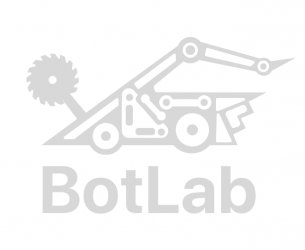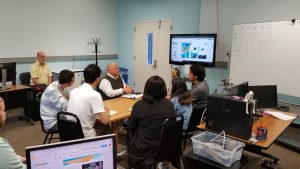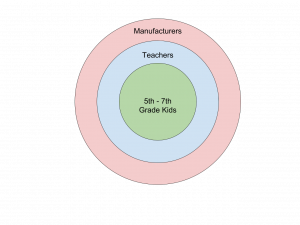WEEK 2:
PRODUCTION:
We dedicated this week to further conceptualizing and researching our final deliverable. As a team, we brainstormed and listed different gameplay types, mechanics, and ideas to incorporate into our product, with a good portion related specifically to AR and learning.
I familiarized the team with methods of agile development: the basic structure, format, and purpose of SCRUM and its components before running them through hypothetical case examples of user stories and the process from backlog to burndown. We constructed a physical backlog and SCRUM board to be used in the coming weeks.
The team put together a concept board breaking down the project’s basic description, inspirations, experiences, needs and goals. Trisha, our lead designer, ran the team through Sabrina Culba’s transformational framework and conducted a collaborative team exercise that broke down each step in relation to our project needs.
We spent the rest of the week preparing for and end-week client meeting and industry expert meeting. Our client meeting was geared towards better understanding the specifics of our deliverable (i.e. target demographic, platform, client needs) and helped us further develop the project’s constraints. We had the incredible fortune of having two regional BotsIQ participants/multi-year champions come in and discuss their experiences with the program, the bot building process, bot driving, and the basic components of a combat bot.
Next week we will dedicate time towards further research, with the ultimate goal of being in a position to start building and entering an early pre-production phase by the end of the week. We will also be meeting with three local teachers and educators that currently participate in the program to gain insight into the educators perspective of the program.
DESIGN:
This week, we decided to do a team exercise using Sabrina Culyba’s transformational framework. Each of us answered 8 questions individually and met the very next day to have a discussion.
This exercise was to find out what each of us thought about 8 aspects of the framework and make sure we were all on the same page.
This is the first iteration of our document: here
This exercise helped us define our goals, player transformations expected by our client and measures of success, better. Our next step would be to operationalise some of the abstract terms like “fun” and “engaging” to have a consistent way of defining these terms and measuring them.
[INSERT HYPERLINK TO DOCUMENT]
UI/UX:
In this week, we spend some time to organize all the information from the 1st client meeting to shape the outline of our project. We brainstormed together and generated all kinds of ideas based on platforms, gameplay, final deliverable and etc. The whole team reached a common sense that AR is a great approach to reach client’s goal.
We generated several directions the project probably would go, at the same time, we also want to build a scope for our project so we had our second meeting on Friday. During the meeting, we asked our questions which was generated in this whole week to explore more about what is the real achievement our client want to have. After the meeting, we found that client gave us a clearer goal for this project is attracting people to join this program. In this way, our previous ideas about replayable and real physical simulation are not in our consideration now.
Student is the most important stakeholder in this project. We also met with experts in this field Joe and Bill with their winner bots on Friday. Talking with the champion of NRL competition is really helpful for us to get a better sense about bot building process.
ART:
In this week, we keep on figuring out our final goals and requirements in our project with our client and instructors. After several meetings, we decided to focus on creating a fun and engaging experience to attract middles school students to join the NRL program and introduce it to teachers and people in manufacturing. But we still needed to define what was a really fun game. The client want our project can show their NRL program well. In order to match our client’s minimum requirement, we should at least make a bots prototyping process with one test in our game. In addition, we met two experts in NRL competitions called Joe and Don. We got lots of knowledge about building bots from them and saw the real bots moving which was really helpful.
We have not started to build art assets this week. But we set our game’s art style in Lowpoly.
PROGRAMMING:
In this week we are trying to find a way to combine AR with the project. We realized that it’s important for us to find several features that only can be done with AR instead of any other technologies.
- AR overlay the virtual onto the real world. We can use AR to connect virtual and reality. Usually manufacturing or building requires user have a physical interaction. With AR, we can make the experience much more similar to the real one than making it in a 3D app.
- Sometimes, it’s good for kids to have an intuitive way to sense the scale of the robots. AR provide them the chance to measure things in a real way
- With the latest AR kit, we have some attracting features like object scanning. One of application we think of is to let kids do some papare work in the real and then use AR to scan into the game for later testing. It simplifies the process of building but still let kids to some sort of practising.


